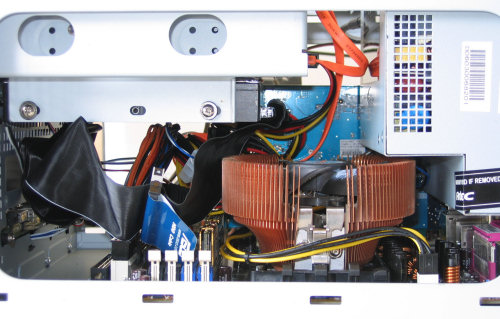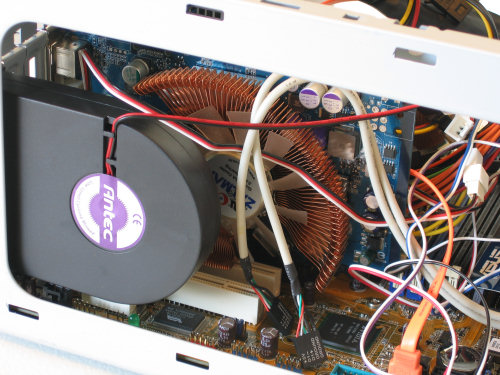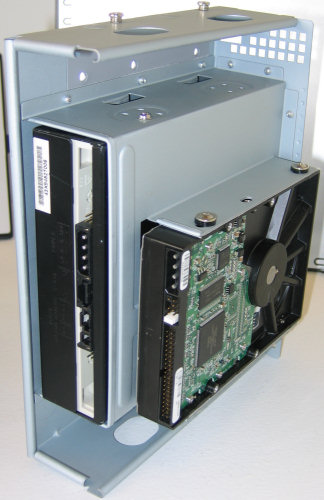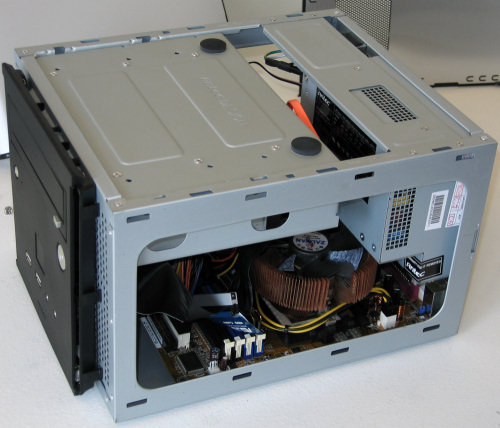Micro-ATX Cases - Shoebox Showdown
by Joshua Buss on January 2, 2007 12:40 PM EST- Posted in
- Cases/Cooling/PSUs
Antec Aria - Interior Cont'd
As with many SFF cases, the drive cage has to be prepared before being put back into the rest of the system. One hard drive fits underneath the optical cage, and two others can hang vertically from either side, only mounted with three screws on one side of the drive. Acoustic absorbing material is in between the vertical drives and the metal, and soft grommets are provided for the single horizontal 3.5" bay.
We had to remove the custom tray cover of our MSI CD burner, but the drive's bezel had to remain so the stealthy cover on the front of the case operated the eject button properly. Getting an SATA (or IDE) cable into the optical drive was a little tricky, but we managed thanks to the ability to hold the whole cage at a half-way open position.
A few more shots of the completed build give a good idea of how cramped things can get in a miniscule case, even if it is well designed.

The right side looks quite a bit better, giving a glimmer of hope to people hoping to put more elaborate cooling systems inside the Aria, as long as the vertical hard drives are omitted.

Antec includes a variable speed blower fan which we installed in the last open expansion bay to help the computer keep up with the moderately high cooling demands from our test bed.

Finally, with the test bed up and running, we could capture the effects of the power and HDD activity LEDs with a slower shutter speed, and this is what we got.

In many ways, the Antec Aria reminds us a lot of the typical Shuttle SFF systems, only it's a bit wider in order to accommodate a micro-ATX motherboard. The final price plus motherboard is lower than what you would pay for an SFF case, and you will be able to upgrade the motherboard in the future. While the case does offer more in the way of expansion options than most SFFs, we would be very hesitant to max out this particular design with three hard drives and four expansion cards. In a more moderate configuration, however, the case works well overall.
As with many SFF cases, the drive cage has to be prepared before being put back into the rest of the system. One hard drive fits underneath the optical cage, and two others can hang vertically from either side, only mounted with three screws on one side of the drive. Acoustic absorbing material is in between the vertical drives and the metal, and soft grommets are provided for the single horizontal 3.5" bay.
 |
| Click to enlarge |
We had to remove the custom tray cover of our MSI CD burner, but the drive's bezel had to remain so the stealthy cover on the front of the case operated the eject button properly. Getting an SATA (or IDE) cable into the optical drive was a little tricky, but we managed thanks to the ability to hold the whole cage at a half-way open position.
 |
| Click to enlarge |
A few more shots of the completed build give a good idea of how cramped things can get in a miniscule case, even if it is well designed.

The right side looks quite a bit better, giving a glimmer of hope to people hoping to put more elaborate cooling systems inside the Aria, as long as the vertical hard drives are omitted.

Antec includes a variable speed blower fan which we installed in the last open expansion bay to help the computer keep up with the moderately high cooling demands from our test bed.

Finally, with the test bed up and running, we could capture the effects of the power and HDD activity LEDs with a slower shutter speed, and this is what we got.

In many ways, the Antec Aria reminds us a lot of the typical Shuttle SFF systems, only it's a bit wider in order to accommodate a micro-ATX motherboard. The final price plus motherboard is lower than what you would pay for an SFF case, and you will be able to upgrade the motherboard in the future. While the case does offer more in the way of expansion options than most SFFs, we would be very hesitant to max out this particular design with three hard drives and four expansion cards. In a more moderate configuration, however, the case works well overall.










37 Comments
View All Comments
jmke - Wednesday, January 3, 2007 - link
Do you have a picture of your test room? 15dB (I guess A weighed) seems awfully low :)JoshuaBuss - Wednesday, January 3, 2007 - link
It is very low.. in our old location we couldn't get any lower than 23 dB and now we're further away from the highway. All I know is that's what my new meter says if everything is silent and the dogs next door aren't barking.JoshuaBuss - Wednesday, January 3, 2007 - link
Whoa, I'm sorry.. it was supposed to be 18 dB. Updated.KayKay - Tuesday, January 2, 2007 - link
I built a machine for my brother using the Ultra microfly and it is a great case. The deciding factors for this was the ability to accept a Full-Size Power supply and the removable motherboard tray. They make this in several colours, as well as clear-sided versions. A small box with the ability to put some powerful components in it! 3800x2 with a 7600GT, this thing runs super quietCuriousMike - Tuesday, January 2, 2007 - link
I *just* built a machine three days ago using the Aria (NSK1300) as the basis; I just wanted something smaller than a tower case. I didn't see the review mention the case as being the NSK1300--- the Aria (IIRC) was all black. The case you reviewed is identical to the NSK1300.My build included a Frys X2 4200 "EE" combo deal with ECS C51GM motherboard.
The retail box AMD fan must have been running full tilt all the time (3000rpm sound right?)... it was the noisiest in the case. The CPU would reach 70' under Prime95 load within about 20 minutes, idleing at around 50'.
I replaced the stock HSF with a Zalman CNPS8000, which was reviewed poorer than the 7000 used in this review. The 8000, at anything other than it's lowest fan setting, is as loud as the AMD retail unit; at it's lowest fan setting, it *just* beats the cooling capacity of the stock HSF; running around 50' idle, and 69' with Prime load.
With the 8000 at full RPM, it only knocks a few degrees... 67'. The machine runs hot.
I used a evga 7600GTS and put a zalman 7000 GPU cooler on it (using the slowest fan setting); that made it go from idleing around 54' to 48', and running ATITool for 15 minutes, stock fan was 71', zalman brought it down to 65'.
With the current fan setup, the machine is tolerable noise wise. It's nowhere near silent.
The NSK1300 is cramped... almost impossible to route cables neatly.
It's pretty slick removing all the panels and the drive cage.
Myrandex - Tuesday, January 2, 2007 - link
I have the Lian Li PC-V300 and given its popularity with this crowd, I would have loved to see it included in there. I look forward to finishing the article as it is great so far.JoshuaBuss - Tuesday, January 2, 2007 - link
There are still a few more mATX cases on deck to be looked at soon.. hopefully the V300 will be one of them too.tayhimself - Tuesday, January 2, 2007 - link
I can't for the life of me find a good uATX motherboard with decent overclocking features for a core2 chip. I would like to build a uATX system but I havent gone with one because of the motherboards.Staples - Tuesday, January 2, 2007 - link
Unfortunately, good motherboards are not made in this size or even micro ATX for that matter. There are some decent P965 boards made in micro ATX sizes but the best ones are all in full sized ATX.JarredWalton - Tuesday, January 2, 2007 - link
µATX, uATX, mATX, and micro ATX are all the same thing. (u is the abbreviation used for mu a lot of the time - m already being taken by "milli" and most people not want to bother with the special symbol µ.)